Well folks, five trilogies and a thousand-some pages later, we have reached the end of the Avatar: The Last Airbender comics. At least I think so. Writer Gene Luen Yang seemed to have signed on just for these stories, and Dark Horse hasn’t announced anything else.
It’s no secret that the comics have been spotty, and even divisive…something not exactly unthinkable for the ATLA fandom. On a personal level, I struggled with some of the odd messaging and plain wonky character scripting throughout, though that didn’t stop me from loving “The Rift” with all my heart, mostly thanks to Dutiful Princess Toph. These comics shine when the focus is on the characters dealing with their inner turmoil, which then in turn drives the plot. For this reason, Zuko’s own difficulty reconciling his duty to his people clashing with Aang’s quixotic and rather outdated worldview is what made “The Promise” a far more engaging read than “The Search”, which was instead driven almost entirely by odd reveal after odd reveal and random bursts of action.
Enter “North and South”, whose third part was released in print last Wednesday, and which will be made available digitally on May 9th. This was a comic I was desperately craving, because if there’s one criticism of these comics that’s been almost constant since they began, it’s that Katara has not been given the narrative agency she more than deserves. A story about the changes that come to the Southern Water Tribe as a result of the war ending, and the resulting tensions between them and the North? Sold. Because of course it would be about Katara’s perception of everything and the way she acts as a change-agent, like she did throughout ATLA’s run. She is mothaflippin’ Katara with the power to stay weather. What could go wrong?

The Little Plotline That Couldn’t
Here’s the thing, and what I said in my review of Part 2: the way the two Water Tribes developed in between Avatar: The Last Airbender and Avatar: The Legend of Korra is the opposite of a complicated tale. In fact, showrunner Michael Dante DiMartino explained it in one paragraph in the Korra Book 2 artbook:
“So here’s a little Avatar history; The South had a long-established Council of Elders to help govern their tribe on a day-to-day basis, though the Northern chief ultimately ruled them. Following the Hundred Year War, the Northern Tribe sent a lot of Waterbenders and resources to the South to help them rebuild. The South grew prosperous over the years, and the North wanted to share in their bounty. They felt they were owed, but the South wasn’t always willing to share what they believed was rightfully theirs. So tensions grew over the years. Chief Unalaq still has some supporters in the South, but he is seen more as a figurehead nowadays.”
It’s not flashy, it’s not an epic battle, and it’s really not even dramatic. It’s just a case where changing economic conditions created slowly building tensions over the course of seventy years, and those tensions eventually resulted in a civil war. Its simplicity is perfectly plausible, especially when contextualized by the way the egalitarian South had been fighting in The Hundred Year War while the rigidly patriarchal North mostly hid behind their wall. The North wanted to make amends and have the tribes grow closer (almost entirely due to The Gaang’s influence and role in the world). When the South didn’t give them whatever they felt was “owed”, resentment built.
There is simply…not much of a story here. Just like there really wasn’t much of a story for Rogue One. We didn’t need to know how those Death Star plans got emailed, no more than we needed to see a grumpy Northerner watching Southern merchant ships set out to hit international markets.
Now, that’s not to say that there can’t be an incredibly engaging story with a relatively mundane backdrop, because again—inner character conflict. Katara, as the only waterbender in the South, could have been the one urging the importance of Northern cooperation as a way to stay connected to their heritage while others may have been more frustrated with the idea of giving the North anything. Whose blood was spilled during the war, after all? Where was Gondor when the Westfold fell?
Heck, maybe Katara even brokers the whole “Chief of both tribes” arrangement as a middle ground, because she’s spent the past however many years flying around the world and making compromises to build a sustainable future. She was there for the founding of the United Republic. She was there when Aang formed the Air Acolytes. She was there when Toph and Satoru found a more tenable approach to industrialization without a negative societal harm.
I always hesitate when it sounds like I’m saying “This is the story I wanted them to tell and it didn’t happen so now I’m sad.” But what I’m actually trying to articulate is that it doesn’t matter what story they told here. There are not enough pressing external forces at play where any of it mattered. All that mattered was that Katara was given an arc that played out with respect to her characterization and experiences, like the scenario just described.
This backdrop…it was a blank slate. The entire thing could have been one meeting about tariff policies, or it could have been about Northerners learning to live in the far-less structured South and the culture clash inherent. In some ways, it’s a backdrop that’s not suited to this medium because there’s not a ton of story. Slow-growing hostilities over the span of decades was not something we needed to watch unfold.
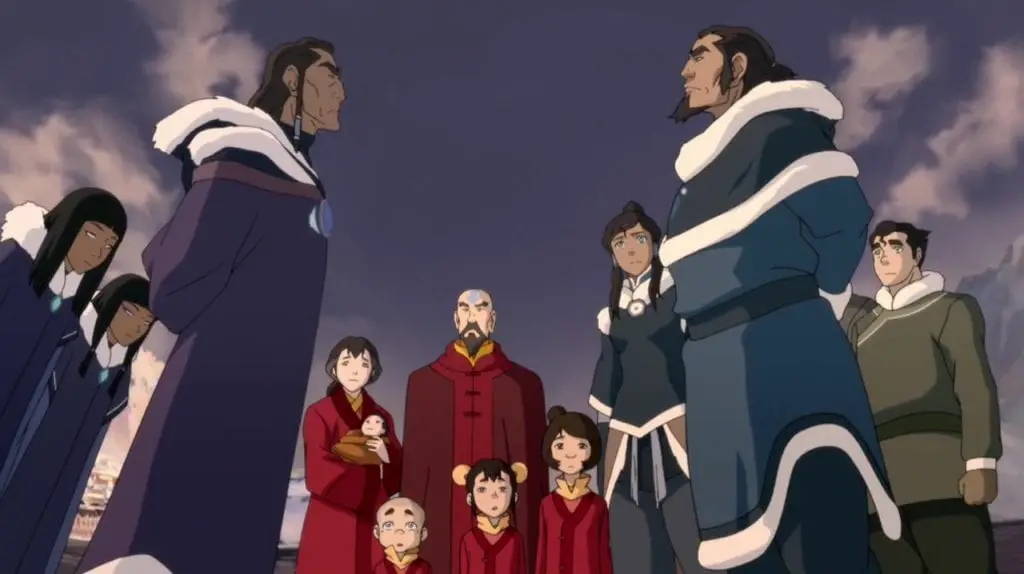
And that’s the real issue with Part 3 and the “North and South” trilogy as a whole: it doesn’t answer the question, “Why am I reading this?”
You’re Oppressing Yourselves!
Instead, “North and South” contradicts the canon from the shows (plus DiMartino’s own mouth) and offers up politics that come with a heaping side of unfortunate implications.
This was something I was very detailed about in my Part 2 review. It seemed really backwards to me that the North would have been the ones to introduce the tacky carnival, or that they were the ones who wanted to excavate the oil at all. It seemed even odder to me that Yang introduced the oil aspect by framing it as being about nonbender equality and therefore a necessary good for the world, but had that point coming out of the mouth of a Notherner who had literally planned on stealing it, saying that the Southerners were too stupid to handle their own resources. A well-intentioned imperialist? What?
The only possible landing for this set-up that I could think of for Part 3 was that maybe the South would all get behind this oil excavation idea, and the North could then feel somehow entitled to the spoils because they…had found the deposit at some point? But this would have glossed over the fact that the North planning to steal the oil is a literal act of war, so what leg would they have been standing on, exactly?
Add to this the main antagonist of the trilogy: Gilak, a man from the South who wanted to fight the Northerners tooth and nail so that the Southerners’ more equal laws and customs could be protected.
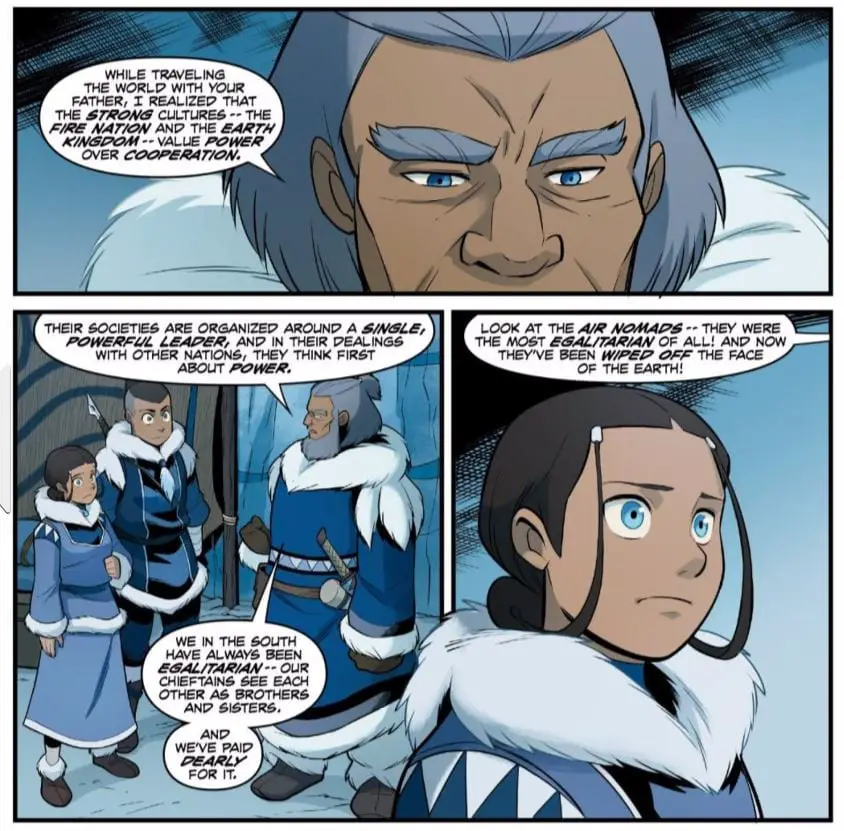
The thing is, it’s not an uncomplicated argument, and given Sokka and Katara’s experiences, they reasonably have a much more hopeful view of both the North and the world at large. This lends itself to a perfect philosophical debate (one that I said was very Pacific Overtures in nature), but not one where the answer is the condemnation of one side. Even Gilak’s willingness to kill to (as he sees it) protect his culture is not simplistically bad. Especially since he had incontrovertible evidence that the North was planning to steal their resources. Again…imperialism!
However, (and be warned of full spoilers for “North & South Part 3” from here on out) just as I was worried about, Gilak was a villain that they played completely straight. In fact, the Southern opposition to foreign intervention somehow got confused with opposition to oil excavation and opening trade routes. So we were left with the people who had very reasonable concerns—you know, the ones who overheard the Northerners saying they had a backward world and couldn’t be trusted with their own resources—looking like, well, close-minded xenophobes:
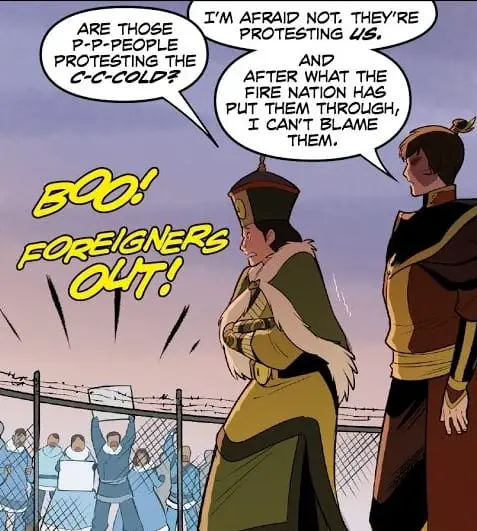
Worse still, nothing about the actual tension inherent in the political situation with the two tribes was resolved. Heck, even the decision to drill baby drill was left dangling!
What’s…happening?
As a quick, quick summary of Part 3’s events: Sokka enlists Malina (Hakoda’s Northern girlfriend) to help with the oil excavation, because Katara refuses to help and Malina has at least seen the plans. From her brother. Who wanted to steal everything. Toph helps with the oil too, using her metalbending students in the process (is this ethical?), while protesters shout at them. Hakoda decides the best thing to do during these tense times is to invite Earth King Kuei (and Bosco) and Fire Lord Zuko down so that he can hold a council to decide what to do with the South. Because if there’s one thing that will help, it’s the leader of the nation who just spent the past hundred years trying to take over the world determining their fate.
At the meeting, Hakoda says he wants to put the South on the global map (they already are, doofus…they were fighting the war), and build embassies, but he needs more resources. Which is, ya know, exactly what the North was supposed to provide, so this seems really redundant, and how is the Fire Nation not already paying reparations? Still, they both agree and Sokka cheers because he likes globalization, but Gilak and his supporters interrupt the meeting! He was freed from jail, and he decides what he needs to do is kidnap Hakoda, who is the “real” enemy.
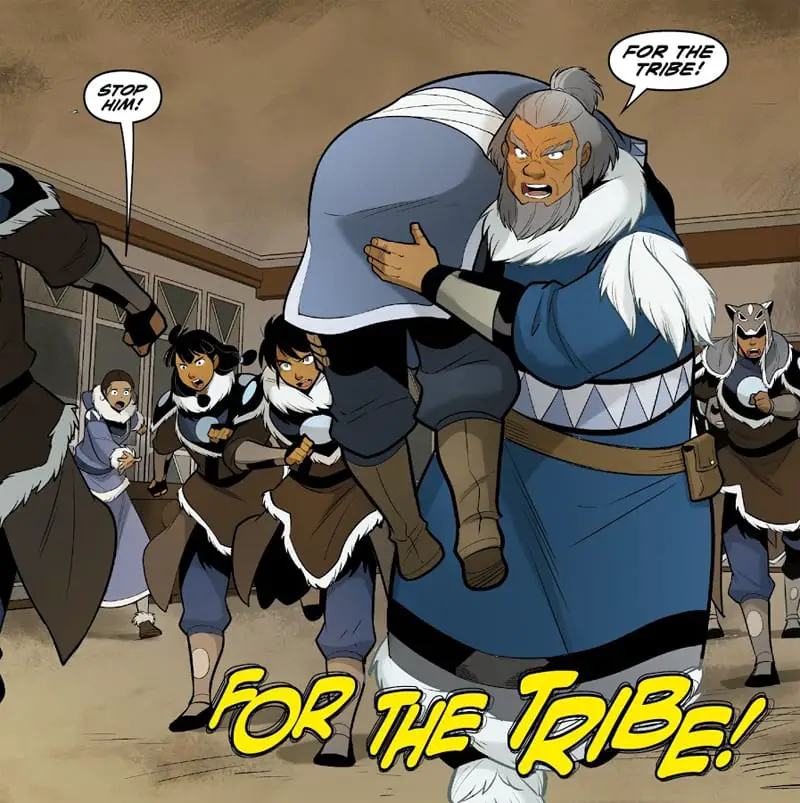
Katara forgets she’s a waterbender and looks out onto the snowy expanse where Gilak is jogging away, saying “Aang! He’s gone!” But Aang, undeterred by a guy moving a bit faster than a walk, airbends her to the action and they save Hakoda. Except wait! No one was watching Kuei, so now Gilak has him. He sends a message demanding that Hakoda exchanges himself for Kuei by going to the “bridge of no return”, where Gilak will send chiblockers across so they can “disarm” the Gaang. Once this happens, Hakoda can present himself at the same time Kuei will be let go. Everyone immediately points out how this is a trap that will end up with Gilak cutting the bridge once they’re both in the middle, but Sokka formulates a plan because he’s perfect.
That plan, as it turns out, is to have Toph invent chainmail so that they’re not really going to be chi-blocked, and also to have Malina be on the other side of the bridge (somehow) to attack Gilak if any funny business happens.
As they get into their places, Katara gets sad and talks about how she always assumed that after the war, the South Pole would “go back to the way it was supposed to be” right along with her and Sokka’s lives. Guess that whole Gaang thing was just a phase for her? Sokka points out how literally no one knows what that means anymore because the war was a century long, and that it seems more like something she chalked up in her mind.
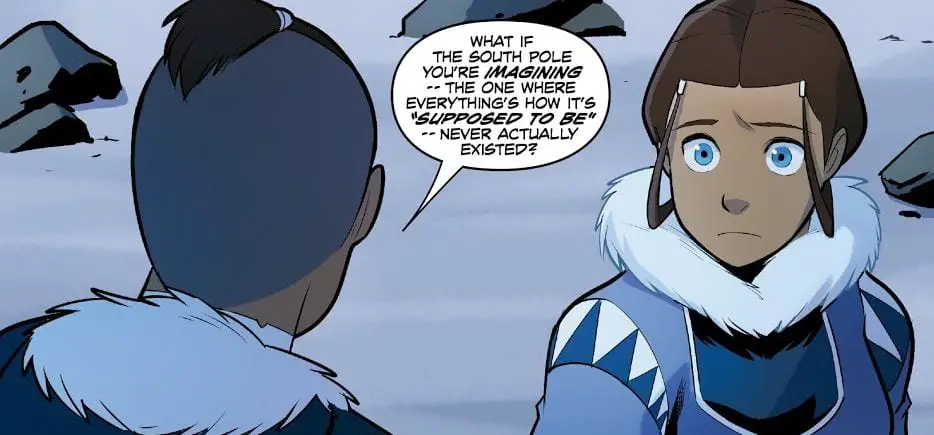
Gilak tries to cut the rope, an epic-battle-thing ensues in which Aang forgets he has his glider for a bit, Toph forgets that earth exists underneath snow, and everyone forgets that Appa flew down there. It ends with Gilak willingly falling to his death (or did Malina drop him? It was very unclear), and Malina letting go to save Hakoda, but Katara rescues her.
Then Katara and Sokka visit their mother’s grave where Katara “tells” her that she was holding onto an image of the Southern Water Tribe that involved Kya still being alive, but it’s okay, because she can feel close to her while bending. Also that she’d probably like Hakoda’s new girlfriend. But she still has to talk her dad out of excavating the oil, for reasons not given.
To celebrate…Gilak’s death? The Fire Nation’s aid?, the Gaang prepares a multicultural feast featuring food from every single nation EXCEPT THE SOUTH.
The end!
When I first finished, I spent a good five minutes asking the final page, “What is this?” Look, I understand that Avatar politics are always a bit glossed over, but this didn’t even go anywhere.
The only thing that changed from the start of the book to the end was that the Fire Nation and Earth Kingdom agreed to chip in and help rebuild the South—something that flies in the face of canon and only confuses the entire plot. Why did they need this aid when drilling for oil had been feasible the past two books? Was it because they were no longer accepting Northern aid? Why is Hakoda still the head chieftain at the end of this when one of the main tensions was keeping Southern laws (and we know there isn’t a head chieftain in Korra)? What happened to all those people with “foreigners out” signs?
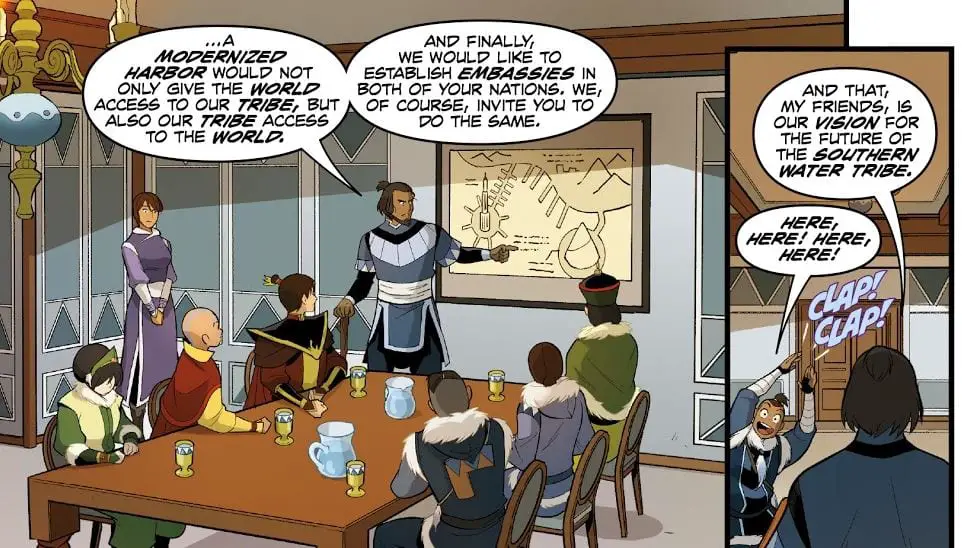
There was no resolution. None. And the only takeaway of this plotline was, “hey that guy who was trying to protect his people’s culture from outside influence is bad.”
The fact that it ends on a feast sampling foods of all the nations too…
Plus, the Southerners had been the ones traveling the world and fighting. It was the Northerners who were talking about how funky Southern noodles tasted and who were more isolationist in nature. It’s one thing for the South to be against foreign influence, but to treat them as though they just didn’t understand the benefit of a global community is to completely ignore ATLA’s canon.
Missing Person Report: Katara
Okay, that’s bad, it is. However, all of this could be forgiven if on the character front, things worked and led to something positive.
To start with something nice: Sokka was absolutely perfect. He crafted the plans like he always has, he had a very future-oriented understanding of things, he was all for globalization because why wouldn’t he be, and his very down-to-earth pragmatism was clear. Of course he invented chain mail, and of course he was the one to point out how even Gran-Gran didn’t know what the South was like before the war. His jokes were on-point too, and avoided turning him into a caricature, which can sometimes happen.
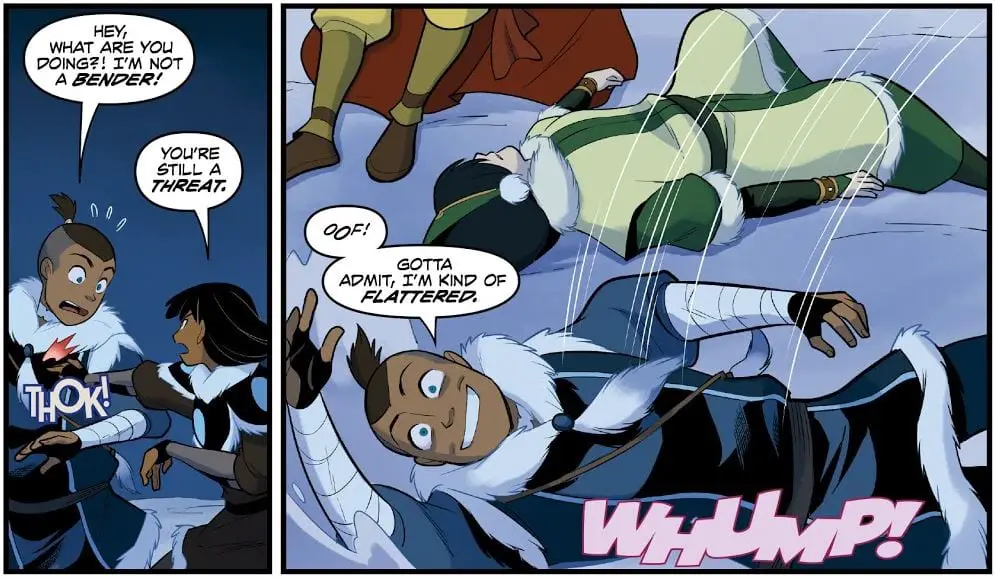
The rest of the Gaang were fine too (Toph always makes me laugh), though why they were there is anyone’s guess. It was too many cooks, in the end.
However, Katara, I don’t even know what to do with her. Apparently she had an idealized understanding of what she’d be coming home to, and it was one based on her mother being alive. Therefore, she was fiercely resistant to any change.
But, that’s…not Katara. At all. She embodies change, and we spent the entire TV-series watching her shake things up around the world, while also learning and engaging with each new area. It’s one thing if she got bad vibes from the Northerners and struggled with her dad dating again, but to be stubbornly anti-development and anti-trade because she missed her mom is a bit much.
Worse still, what makes her come around is that she realizes she can feel close to her mother when she waterbends, because it reminds her of the courage she inherited. Except, she mentions feeling this rush of courage as far back as the end of Book 1’s events. Oh, and she and Haru had a conversation about this exact point earlier than that, in episode 6.
Katara: So that’s why you hide your earthbending.
Haru: Yeah. Problem is …the only way I can feel close to my father now is when I practice my bending. He taught me everything I know.
Katara: See this necklace? My mother gave it to me.
So, after everything, after watching Aang struggle with the same dang issue in every other comic (the Air Nation’s and the spirits’ place in the world), not to mention everything she personally went through on the show including but not limited to hunting down her mother’s killer, she still wasn’t able to look at her tribe’s economic development objectively. She needed Sokka to remind her of how she conceptualizes her culture, when in the pilot episode we heard how she had centered on bending as a way to feel tapped in. It’s why she LEFT HOME IN THE FIRST PLACE.
Katara: It’s not magic, it’s waterbending! And it’s—
Sokka: Yeah, yeah, “an ancient art unique to our culture”, blah, blah, blah.
This was not a character arc Katara needed at all, because this character simply wasn’t Katara. She has a bit of inner darkness that we saw come out during the show, and she has some judgmental tendencies at times too, so it’s not like she is without flaws or without potential conflict. Heck, rewatch “The Chase”. It’s just that this one was not for her. It was an Aang storyline, when you think about it, and one we’ve seen explored through him multiple times at this point.
Four Was Enough
“North and South” was a disappointing close to the comic trilogies, but at the end of the day it was a victim of its own making. Out of the host of other conflicts that could have arisen in this time period, the one selected was the least expensive, and trying to manufacture a plot with exciting action in it (can someone tell comic writers this isn’t a requirement?) within that framework was always going to be an uphill battle. Unfortunately, this also was presented with a host of disturbing political implications, and a protagonist stuffed into a box she never wanted or needed.
Now if you’ll excuse me, I’m going to put on “Southern Raiders” and watch Katara battle her inner demons.
Images Courtesy Of Dark Horse Comics And Nickelodeon
AVATAR: THE LAST AIRBENDER – NORTH AND SOUTH PART 3 Credits
Writer: Gene Luen Yang
Art: Gurihiru

